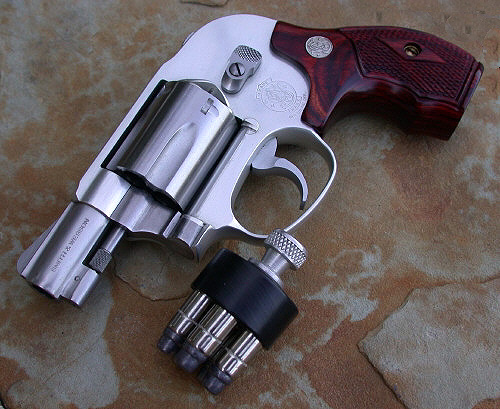
"House" vs. "Carry Guns"
A very frequent question centers on what to get for either a house or carry gun as well as choice for the person wanting one for both. With about the same frequency come questions on loads, calibers, and the guns themselves. I already have some articles that hit at my opinions on these topics, but thought that it might be time to focus on these questions in one article as "house" vs. "carry" pretty well covers the handgun self-protection spectrum.
I can only make suggestions, but they are based on personal experience spanning over 30 years. Perhaps they will be useful, perhaps not. I think that it is impossible to speak in absolutes on this topic, and the reason is simple: There is no way that I can know the individual's handgun skill level or their unique lifestyle, home situation, and so forth. Each of us will have to make our own decisions based on our personal perceived needs. I can only offer what I hope is some assistance in this decision-making process.
Let's begin by asking the question, "What do I want my defensive handgun to do?" Initially, this seems silly and an adequate response might be, "Protect me and mine." That's true, but might not a more accurate response be, "My defensive handgun is one that gives me the tool with which to stop unlawful deadly aggression against me and mine with the least number of shots (assuming good hits), and not endanger innocent third parties?" In other words, though we might not get the all-elusive "one-shot stop", neither do we hope to have to expend our handgun's full capacity to deck our opponent. This implies at least a certain minimal power level along with the person being competent in the use of his handgun, probably in compressed time frames and definitely under stress. It also suggests that there must be concern for uninvolved innocents in the area. I would add that the house gun should be of a caliber that can be handled by all potential authorized users. It must also be one that these users can operate…while scared to death. Whether a house or dedicated carry gun, it absolutely must be reliable. I cannot emphasize this point too much; the thing has got to work whether held in a strong man's death grip or an arthritic's less-than-ideal weaker hands.
Notice also that I used the word "tool" instead of weapon. This was for a purpose and to emphasize that the handgun cannot protect you. It gives you the means by which to protect yourself. YOU do it by having both the willingness and competence to properly use the tool. Think of it as the flip side to "Guns don't kill people. People kill people."
So here we go.
Carry Handguns: In addition to the previous caveats, the carry gun shouldn't be too heavy or large for its purpose if it is to be carried on the person. One that's only to be toted in a glove box or console is not quite so limited. In fact, its characteristics might be nearly the same as for the dedicated house gun. Opinions on the "best" handguns seem to range from the tiny little mini-revolvers to handguns of considerable size and weight. Much of this depends upon how serious the would-be user is about defending his or her life. People like myself in low-threat environments are frequently found with smaller, more convenient to carry handguns, but when I worked in high-risk situations (police work), I was always armed with more potent weapons 24/7. The lady carrying a legally concealed handgun on walks around her normally crime-free neighborhood is probably less motivated to carry a larger, harder to conceal handgun of heavy caliber than the jewelry store owner who has been robbed multiple times.
Mr. Clint Smith of Thunder Ranch has said that (defensive) handguns are not meant to be comfortable. Instead he opines that they are meant to be comforting. The jewelry storeowner might not be comforted with only a comfortable-to-carry 5-shot 38 snub where this might be just the thing for the walker. It is true that we simply cannot predict when we might find ourselves in "the dark place." This is where our own perceived threat level comes into play and this brings with it a large percentage of people choosing smaller and easier to carry handguns.
I see this as the so-called mixed blessing. Let me explain why.
Assuming at least minimal handgun competence with lawful concealed carriers, I do believe the saying that an armed society is a polite one…at least more "polite" than a totally neutered one, and more importantly, safer. I suspect believe that if would-be muggers and car-jackers thought that at least one out of two potential victims were armed, they'd either find easier pickings or be damned selective in their victim choices.
At the same time, we shouldn't choose the most "comfortable" gun based on that characteristic alone. I suggest that we need a minimal power level to meet or exceed. For me, that is a snub 38 loaded with my choice in +P ammunition. Others will not be happy with less than a heavier caliber though some will opt for the smaller 380's and even .25's. Opinions on "adequate" and "best" vary greatly and are often the topics of rather heated debates.
The potential carry gun should be one that we can shoot accurately enough to actually hit intended vital areas, not just somewhere in the torso at arm's length or father. Keep in mind that the comfortable-to-carry snub 38 can be one of the more difficult guns to learn to accurately shoot with felt recoil in the lighter ones being a chronic complaint. I believe that they can be adequate defensive arms in competent hands in less than gang-type shootouts. They will almost surely be slower to load compared to the automatic, Mr. Miculek excluded! What I am strongly suggesting is that unless one is willing to dedicate himself to proper practice with the lightweight snub, he might very well be better with a gun that is a bit less comfortable. It may very well be easier to shoot well. The very attributes of the comfortable compact snub are also the very things that make it difficult to shoot. "Lightweight, small and convenient" describes some of its positives. "Heavy recoil, limited ammo capacity, hard to aim and short sight radius" is the other side of the same coin. Other negatives include that the extractor rod will probably be too short to completely extract fired hulls for the unpracticed and these guns normally hold five to six shots compared to roughly twice that in some similar size automatics. Five or six is probably enough against a single or maybe a couple of thugs but not if it takes three shots to even get a hit on just one bad guy…and he opts not to run! Though I am a big fan of the snub 38 and think it makes a decent carry gun, I do not recommend it except for those actually willing to learn its use.

The S&W Model 638 is a representative of the lightweight snub 38. Like the very popular Model 642 it makes a carry gun that is convenient and packs at least "respectable" punch in my opinion. Like others of its kind, felt recoil is sharp and sometimes just too much for some shooters. All-steel versions of the gun or in similar size might make for a bit less convenience but might absorb enough of the recoil due to weight to make it a viable substitute. Whatever is chosen, it does no good if it cannot be shot accurately at speed in the arena of self-protection.
I am not a fan of the super-compact 380's. I prefer them in their more traditional sizes with barrels over 3" to at least keep velocities in the "normal" range. Examples of what I'm referring to are autos like the Bersa Thunder, SIG-Sauer P230 and P232, or Beretta Model 84/85. Some folks opt for these over the snub because of increased shot capacity, reduced felt recoil, flatter profile and being magazine-fed, ease in reloading. I own and enjoy some .380 ACP pistols but the "ballistic payload" is just a bit less than I'm comfortable with. If you are, no problem; learn the gun; know that it's reliable and practice getting accurate quick hits. At the same time, I suggest looking at the similar size 9x19mm pistols. It seems that with the 380 one can have penetration or expansion but not both. FMJ will certainly penetrate, but offers a small wound channel. Some 380 JHP's actually do expand, but have trouble meeting or exceeding 12" penetration in ballistic gelatin as per the FBI protocol. For an unobstructed frontal shot, they may very well be adequate…but many, myself included, believe that they are marginal. IF the only choice is between a snub 38 or 357 that you simply cannot hit with and a 380 that you can, go with the latter. Otherwise, I humbly suggest going with a 9mm or larger in the small automatic.
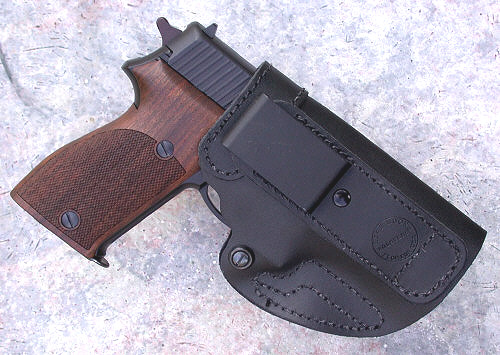
Though not a small gun, automatics in the size range of this 9mm SIG-Sauer P225 can readily be found. Carrying concealed will require "dressing around the gun" but is not all that hard to do. This one could certainly do for concealed carry on mean streets and protect at home as well. This one is shown in an IWB holster by High Noon. By using a quality gun belt and holster, even larger handguns can be effectively concealed. Most will find such handgun's felt recoil less objectionable by far than the lightweight snub 38.
At the same time we are not well served with a carry gun that is overly powerful for our personal skill levels. Few would argue that an individual who can accurately shoot his or her 380 but cannot a 45 to be better off with the latter. It is for this reason that I personally prefer lightweight compact revolvers in .38 Special rather than .357 Magnum when they're offered in both. In the medium or compact steel frame revolvers, I find the .357 more useful due to less violent recoil than in the lightweights. In other words, what works for me in the S&W Model 442/642 weight is .38 Special +P despite some similar weight revolvers being available in 357. In a heavy but compact Ruger SP101, I opt for mid-range 357's.
Moving up in size, adequate choices increase. We find a myriad of 9mm's and 40's available in easily concealable sizes though these will be belt rather than pocket gun…depending upon the size of the pocket.
Some 45's can be found in nearly as compact of packages, but the selection is smaller.
The carry gun larger than a snub 38 or really compact 380 will in most cases need to be a belt gun and this can entail a bit more selection in clothing as it is simply more difficult to conceal a belt gun than one secreted in a pocket holster. Just how much more difficult depends on a number of factors including the climate, size and even the sex of the carrier. In other words, besides practicing to be competent with the firearm, we also have to consider how to most conveniently cover and carry it. The choice of a quality belt and holster can make it easier to carry a bigger gun than might first be thought. If one opts for and IWB (Inside the Waistband) holster, it will probably be necessary to buy a size or two larger pants.
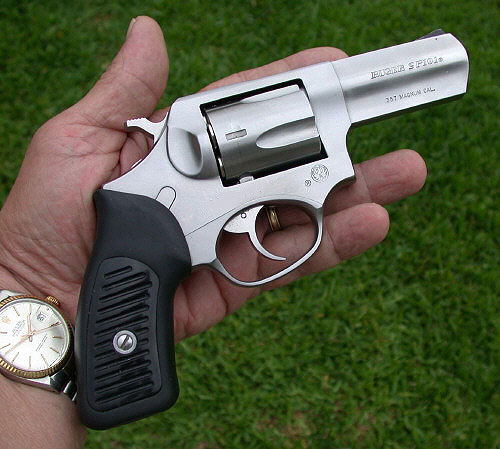
This Ruger SP101 has a 3 1/16" bbl and is chambered for .357 Magnum. Its all-steel construction increases its weight enough that I find it considerably easier to shoot full-power magnums through than lightweight revolvers of the same general size. The downside is that this one is a bit too long and heavy for pocket carry. However, it makes a very nice belt gun and one that is easy to conceal. For myself, I find the revolver at its best with the mid-range magnum loads with regard to power vs. controllability. If its 5-shot capacity doesn't bother you, this is one that might be able to do double duty, serving as both a carry gun and one for home defense.
The plus side to the less comfortable larger carry handgun is that we usually get increased shot capacity, increased sight radius and probably better sights, increased velocity due to the longer bbl, and less felt recoil. Generally speaking, larger automatics will show themselves more reliable and less "picky" than smaller ones, not a hard and fast rule, but very frequently. If speaking of revolvers, we often get 6 rather than 5 shots, an easier double-action pull and some of the same positives as for the autoloader.
In my opinion, all of these considerations are worthy of serious thought but two people giving equal thought and attention to detail may very well come up with two very different choices in armament…and both may be very right for their individual situations.
House Guns: Though these do not necessarily have to be handguns, the focus here will be on the latter. The need for a compact house gun in most cases would not be as important as for the carry gun in my view. Certainly a hearth and home could be defended with a J-frame 5-shot revolver but why? Unless there is some external reason such as local laws limiting handguns or making their access nearly impossible or financial considerations, it is my belief that the house gun can be of larger size. The larger guns carried by serious folks concealed (1911, Glock 17/19, etc, Hi Power, 3" or 4" K, L, N frame revolvers, etc) could certainly perform both functions admirably.
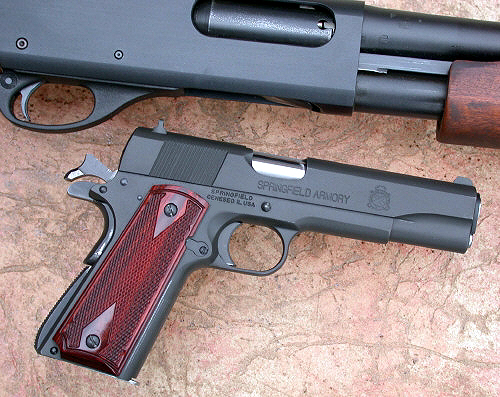
Though there is definitely a place for the long gun in home defense, this article focuses on the sidearm. The 1911 pattern pistol in .45 ACP continues to serve well as both an effective carry and house gun. Despite the fact that its devotees are legion, does that necessarily mean that it's best for you? The 1911 type handgun is a large but relatively flat pistol and one that can be carried concealed though this can require some thought. No such limitations exist for the house gun. The gun holds 8 or 9 cartridges depending upon magazine capacity and can be reloaded quickly if necessary.
In short, we may have to make some compromises with the carry gun depending on several factors but the concealment factor for the house gun is of lesser importance. By going with a larger and perhaps heavier handgun, you are probably going to find that your ability to shoot the gun well is easier than with a really compact carry gun. Assuming a longer bbl, you will probably wind up with more "power" per shot even if in the same caliber as the smaller carry gun. For example, the 3" and 4" .38 Specials show a very nice increase in velocity with many factory loads, but even assuming that they didn't, their longer sight radius and lessened recoil might very well provide for better hits. A "chest hit" with the snub might translate into a "center chest hit" with Model 10 4" for the same level of skill. Split times between accurate shots might also be significantly reduced, especially with practice.
Larger steel-frame handguns not only reduce felt recoil but in some instances allow the shooter to move up to a more powerful caliber. For example, a fellow might find a super compact .380 ACP or AirWeight J-frame a bit punishing to shoot while he finds a 1911 pattern pistol in .45 ACP to be controllable with practice and more comfortable. With felt recoil being subjective, this decision will have to be made by each of us individually.
Let's say that a shooter has chosen the lightweight J-frame snub 38 for a carry gun. It would make sense that the house gun might be a steel Model 10 or something similar. Even if the Model 10 had the short 2" bbl, the shooter gains an extra shot and will almost certainly find the gun easier to shoot (assuming the same ammunition) than the smaller, lighter AirWeight.
The "extra shot" just mentioned also leads us into thoughts on ammunition capacity. Though I personally use and greatly respect the revolver as a house gun and do think that in most instances six shots are enough, does that mean always; no, probably not. If we experience the proverbial "bump in the night" and simply have to investigate, will we be carrying extra ammo or just our house gun? Will we have time to dress and drop a speedloader or two into our pant or robe pocket? Will we be "satisfied" with our otherwise "comforting" revolver or might we prefer a higher-capacity autoloader? This is something to consider and if the answer is that you just have to have more shots on tap to feel comfortable, the revolver might not be the best choice.
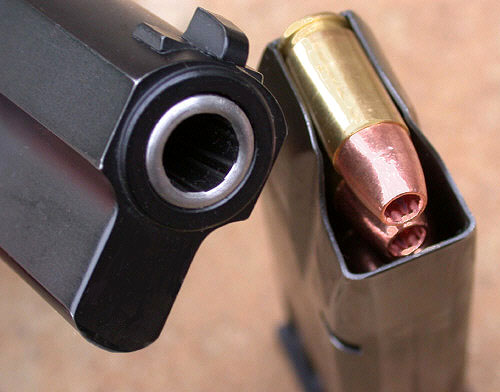
If having more than five or six shots on tap per loading is a vital part of your house gun parameters, the 9mm seems a popular choice. Offering from 10 to 17 (or more) shots per loading depending upon the gun, these pistols are usually mild on recoil and much research has been done in bullet design for this caliber. The Browning Mk III above is shown with a magazine containing 13 rounds of Corbon's excellent DPX ammo.
The person carrying a compact automatic such as the Glock 26 might find the larger Glock 17 or 19 a preferable house gun, while maintaining unity in the same manual of arms. Please note that the above examples are merely that and no more. In other words, I am not trying to recommend a specific handgun, just offering food for thought that might be of some use for the individual contemplating these matters.
Like many others I prefer "dark" guns to "shiny" ones but my "always gun" is a shiny one. It's a Model 642. In my state, summers are very hot and despite a horsehide pocket holster, my previous blue carry snub would frequently show the beginnings of surface rust, despite being cleaned the day before. It might be a wise thing to give some thought to the finish that you believe might be best suited to your situation rather than the one you prefer esthetically. For the house gun, I see the choice between "traditional blue" and other more corrosion-resistant finishes as less of an issue with but one caveat. If the gun is being stored in a bathroom, I'd go with stainless steel or some other rust-resistant finish as the bathroom will frequently be a humid environment.
I'd like to touch on the "power" issue once more. It is my opinion that while "placement is power", we need at least a certain level of "power" in order for the defensive bullet to both expand and penetrate adequately. I favor at least .38 Special +P and 9mm up for this task. Often, the (wise) suggestion to use "the biggest caliber that you can handle" is given. How do we know what the biggest is? How do we wisely answer this question before coughing up hard-earned dollars for what might be the wrong choice? Couple that with the wide-held belief that no handgun caliber commonly associated with self-protection is really all that "powerful" and the choice is made more difficult. The prospective buyer of a self-defense handgun wants a gun he can handle but also wants "stopping power", which is usually associated with heavier or harder recoiling cartridges.
Here is a suggestion. If at all possible shoot handguns in the calibers and models you are interested in before purchasing. Perhaps a friend can help out in this regard. Models don't have to be the exact model you might be wanting but something in that class of handgun. For example, let's say that you have decided that an S&W Model 638 is just the thing, but shooting a friend's Model 642 proves that at your present skill level, you cannot handle it. This should let you know that the similar size and weight Model 638 isn't going to be any better. Other examples can be made, but I think you get the idea.
I also suggest shooting the considered handgun with not only both hands, but with just the strong and weak hands as well. Though few of us can shoot quite as quickly and accurately using but one hand, this does not mean that we might not be called upon to do it in a life-and-death situation. I believe that this applies to not only the house gun but the carry gun as well. It is written nowhere that when push comes to hard shove we will have the use of both hands. I would go with nothing more powerful than what I could effectively handle with my weak hand. If you try this and the caliber of choice is just too much, it might be time to look at a less potent one. If going below this power level is simply unacceptable, practice and learn to handle the gun or load that you have more faith in.
In closing, I again suggest nothing less potent than 38 Special +P for the revolver and 9mm and up in the automatic. Within this range is a myriad of handguns in varying size and weight. Pick what works for you or that you are definitely willing to learn to handle. Hopefully, you'll get it right the first time, but don't be surprised if you don't. It might take a couple of times at the gun shop and firing range before it happens. Though I have yet to find the all-elusive "perfect" handgun, I have found more than a few that seem nearly so to me. When you find what is best for you, go with it. It doesn't matter if it's the latest design or just a good time-proven older one. Go with a reliable arm whatever your choice turns out to be. Don't be goaded into getting a "magnum" if you truly do better with a hot 38. Don't get rid of the 9mm you can hit with for a 10mm or 45 that seems just too much. (If the 10mm or 45 works for you, go for it.)
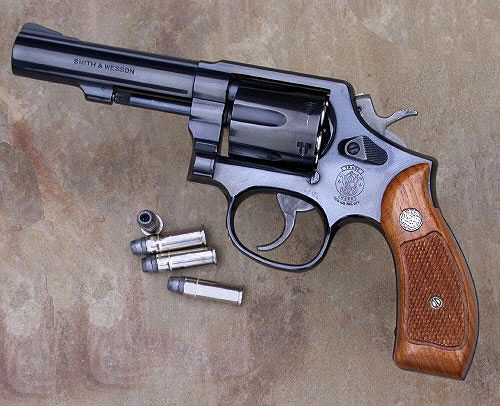
This 4" S&W Model 10 is chambered for .38 Special and is much easier to shoot than its snub-nosed brethren due to its increased size, weight and sight radius. As I've suggested in another article, for many this sort of firearm might just be the "best" for those not especially well-versed in defensive use of the handgun. From the 3" or 4" barrel, its ballistic delivery can be effective and most folks find these firearms relatively easy to use. I would not be afraid to use this revolver in a serious situation. The gun has also been offered in stainless steel for those wanting more resistance to the elements.
The selection of the defensive carry or house gun is one that requires some thought. Most of us will never use either but if we do, our decision could very well mean the difference between telling what happened to responding officers or being represented by a chalk diagram to homicide investigators.
Seasoned shooters will have made their choices, but sometimes the selection of defensive armament can be a little unnerving to newer people deciding to take responsibility for their personal safety and that of their loved ones.
We want it to be right. I cannot "tell" anyone what's best for them but hope that this piece might add in their making sound decisions in this vital area of concern.
Best.